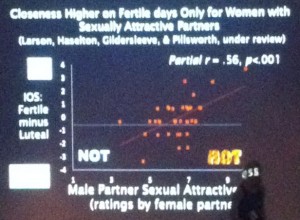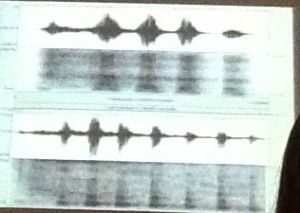The Human Behavior & Evolution Society (HBES) 2012 Annual Meetings took place this past weekend in Albuquerque, NM, in conjunction with the Animal Behavior Society, hosted by Steve Gangestad & others. I’ve only been to HBES one other time & that was way back in 2002, the year I started grad school. At the time, I didn’t know who anyone was or what was going on. Not much has changed, so forgive my naivete. I spent the conference tweeting re things that blew my mind, which, no doubt, you already knew about.
The highlight, for me, was realizing that there is more to the nifty newish “parasite-driven wedge” hypothesis (PDW) I wrote about recently, much more. I will spend this post reviewing talks related to the larger “behavioral immune system” paradigm, of which the PDW is an aspect, as well as other highlights, then write in more detail about the scope of the behavioral immune system in the future, as I delve into the literature. But, rather than leave those of you as naive of me hanging, the behavioral immune system (BIS) is “a suite of mechanism that serve to provide a first line of behavior defense against pathogens” (Schaller & Murray 2011: 107).
There were four concurrent sessions most days, so I can only write a little about some of what I saw. Fortunately, there were some good tweeters there sharing information from other sessions that filled in a few blanks. Unfortunately, the program coordinator didn’t print affiliations in the program & appears to have gotten burned out with printing whole first names too, so I have names or partial names for some people & may not actually know what they’re background is or how you can find more info. I would be happy for comments that fill in the blanks.
The first of note for me was Christopher J. Clark, who gave a talk called “The role of power versus energy in courtship: What is the ‘energetic cost’ of a courship display?” His focus was on the conflation of power & energy expenditure when measuring signaling displays. He compared hummingbird courtship displays to sprinters like Usain Bolt, suggesting that animal courtship displays represent extreme performance. A 100 meter dash is analogous to a hummingbird courtship display in burst & time. He said that, when measuring the energy burst in a hummingbird display, <1% of the bird’s daily energy budget is used, which can be replenished by feeding at one low quality flower. This suggests such displays themselves may not be so ‘costly’ as signals as the “costly honest signaling” model might insinuate. But, signaling costs should not necessarily be measured in the burst but in the development of the capacity & training for the burst/display, which is simply a culmination, but a marvelous one to behold & one that should be measured in time & energy investment. In this sense a measurement a power capacity makes more sense than one of energy reserves.
Gregory Bryant gave an interesting talk on “The animal nature of spontaneous human laughter,” beginning with the laughter of mice. Yes, mice laugh, apparently when you tickle them. All kinds of communication forms that we tend to anthropomorphize actually predate human speech, such as “orgasm calls,” laughter, & crying. These communication sounds have likely been subject to selective pressures longer than language & therefore we have developed ways to detect when they are insincere & efforts to manipulate, as with Duchenne smiles. It is possible to tell the difference between genuine & fake laughs because fake laughs tend to be slower (as he demonstrated by playing us slow & fast laughs, which we were able to distinguish & which are illustrated by different amplitudes). We know the manipulation of a fake laugh isn’t necessarily a deception. It may be an effort to affiliate by saying, “I know you told a joke, that much I get & am communicating that I know you told a joke, but I don’t actually have access to enough cultural information to know why it’s funny.”
I skipped over to another session to catch M.W. Campbell present “Contagious yawning as a measure of involuntary empathy by chimpanzees for humans.” Campbell is apparently a researcher at Yerkes Primate Center in Atlanta & his interest was in testing contagious yawning in the chimps to understand the degree to which the researchers are part of the chimps social world. Contagious yawning has been considered a proto-form or of theory of mind, likely triggered by the mirror neuron system, which signals empathy to ingroup members. Given their close relationships with the chimps & the fact that they are constantly giving them treats & never doing anything unpleasant to them (like the veterinarians), Campbell thought the chimps might display contagious yawning, suggesting something positive about their relationships with the researchers. The method they used was to show the chimps iPod touches with familiar & unfamiliar humans & gelada baboons yawning. They included gelada baboons as a control primate, given the chimps have no expsure or interactions whatsoever with geladas. What they found surprised them, as chimps display this volunary empathetic response to all humans despite the different interactions repertoires they experience with them. They didn’t display this reaction at all with respect to the geladas, which is how they behave toward outgroup chimps (antagonism trumps empathy?). One explanation may be that, since researchers come & go with such frequency (some of these chimps are several decades old & have seen their fair share of Ph.D. students over the years), humans have come to just be humans & if you’ve seen one, you’ve seen them all. He hopes to test this by testing how the chimps react to the yawns of the vets & to run the same experiment testing bonobos, which may show empathy toward outgroup members.
I came in late on a double-symposium on pair-bonding moderated by Joan Silk. The first half as animal talks, the second human. I got a little woozy during Elizabeth Adkins-Regan’s talk from just having had lunch then snapped to as things got really interesting & wish I’d picked up on more. She was discussing “The neuroendocrinology of socially monogamous pairing by birds.” Essentially, these birds are actual truly monogamous, unlike the mammals others have looked at in trying to study the neurology of pair-bonding, which makes them superior models. In one study, she found that estradiol treatments & growing up in an all-female aviary during development switches the sex of partner preference in finches. I think this was in females, as she was talking about the aromatization process. In another study, she found that suppressing the activity of both estradiol & testosterone did nothing to suppress pair-bonding, suggesting that they are not the key ingredient, though they play big roles in other sex-typic behavior.

“Martie (Haselton) shows that if you are not an attractive male, you should keep your woman off estrus :)” (Photo & tweet by Igor Miklousic).
Evolutionary psychologists Steve Gangestad & Martie Haselton co-presented a talk on human estrus & pair-bonding. Gangestad suggested there is evidence that humans, chimps, & orangutans are all more discriminate during what we call the fertile phase in humans or estrus in other mammals. This means that the loss of visible signs of estrus in humans is not necessarily the mechanisms that influenced pair-bonding in humans (to keep a man around providing resources, since he’d never know when she was ovulating, according to the theory). This fertile phase is, as evidence Haselton presented suggests, much more complicated than such a simple one-to-one design principle. Women’s preferences are heightened with regard to short-term mating encounters. If the mate quality of a spouse is low, these preferences may serve to facilitate trading/mating up thru EPCs (extra-pair copulations), as women report feeling less close & more critical of their partners at high fertility.
Next up, Rob Boyd posed the question, if cross-culturally & pan-historically great wealth & income differences generally came with polygamy & enhanced reproductive success, why aren’t Bill Gates & Barack Obama not “frollicking with concubines?” Cultural marriage systems, he says, affect mating systems, as they are not the same. Pair-bonding is associated with complex societies & correlated with a reduction in crime. Widowing is a natural experiment, as data suggests that young, unmarried males are more likely to commit crime, as statistic that drops when they get married then spikes again when they are widowed. A recent study by behavioral economist Edlund et al (2007) looked at the one-child laws in China (which are not monolithic but vary region to region) & found that a 0.01 increase in sex ratios result in 3% increase in crime!
Finally, biologist Mary Jane West-Eberhard gave the evening plenary on “social selection,” which she says is due to fitness effects of social competition for resources. Aggressiveness & attractiveness are two kinds of social selection. She illustrated the principle with the horned beetle. The horn of a beetle is not simply selected for intrasexual aggression; there is a “predictive adaptive switch” that moderates the phenotype. Horned beetle larvae poorly nourished during development neither develop horns nor fight, whereas well-nourished larvae develop horns & engage in fighting. Obviously, it would be maladaptive to be born without a horn & still have a predilection for fighting, so some switch related to nourishment triggers a suite of adaptive changes. I sensed her going in the direction of the fetal programming/thrifty phenotype/Barker hypothesis, which indeed she was (“thrifty adaptive switch”). I am still unclear if she was in fact reifying the “small but health/adapted” model. She suggests that a number of body shapes may be the result of social selection. For instance, the hourglass in women is rare & only occurs in young women. The “apple” (which West-Eberhart says looks more like a pineapple or barrell) & “pear” shapes are more typical but only the pear is associated with health risks. These risks are associated with deterioration in an organ called the omentum, which most of us have never heard of. The omentum plays a key role in metabolism, feeding behavior, & immunity by producing macrophages. The social selection hypothesis, then, is that alternative metabolic pathways are a response to nutrition in stratified societies. Plasticity in such cases is a phenotypic accommodation that can be inherited (& become epigenetically predisposed), since selection operates on phenotypes. In stratified societies, food went to the haves & not the have-nots, which was a result of agriculture. Plasticity in phenotype was needed because of changes people might experience in rank with social mobility & war. Rapid evolutionary changes could accompany this because of the selective pressure of severe nutritional stress. Have-not phenotypes can predict past nutritional stress because of changes in their omentum. The question remains, what genes change under nutritional stress? There are testable predictions from this model: viseral obesity & diabetes should be at higher rates in populations with severe ancestral diet stress. Cultural displays (art & clothing) might be found that emphasize rank associated with body shapes (e.g., corsets, Victorian bustle waists). To understand what is going on with plasticity with regard to behavior, West-Eberhard says, it’s best to look at actual behavior, to do it across a lifetime (not synchronically) & to do it where the behavior evolved (before it’s gone & it’s too late).
That’s just the first day…




Pingback: HBES Roundup 4: Father’s Day & the Parasite-Driven Wedge | Welcome to the EvoS Consortium!
Pingback: HBES Roundup 2: Brian Hare’s Chimp/Bonobo Cognition Plenary, Mommy Brain Fogs, & Baba Brinkman Evolution Raps | Welcome to the EvoS Consortium!
Pingback: HBES Roundup 3: Kissing Petri Dishes & Staring at Gross Things to Get all Hot & Bothered | Welcome to the EvoS Consortium!